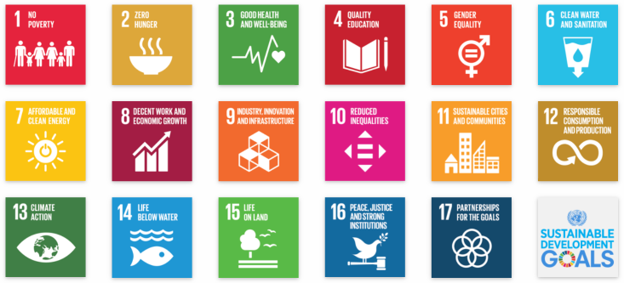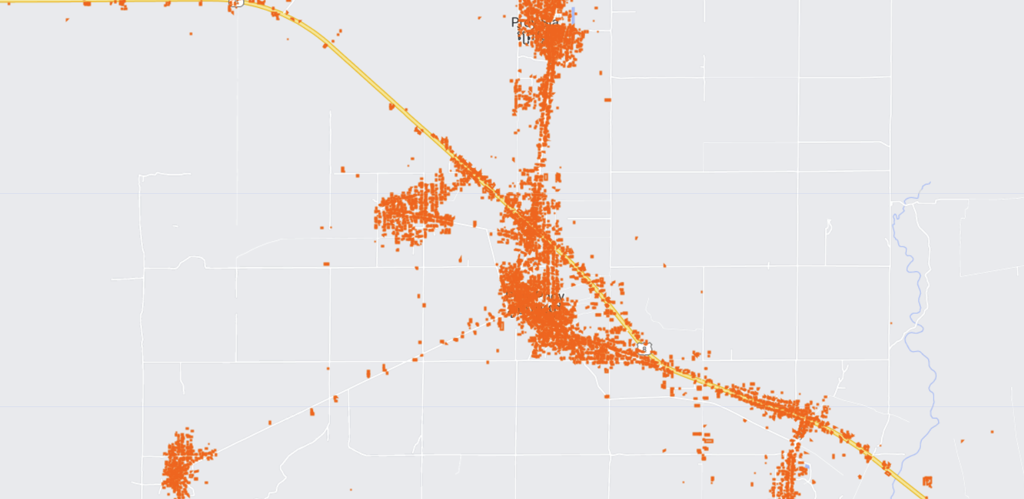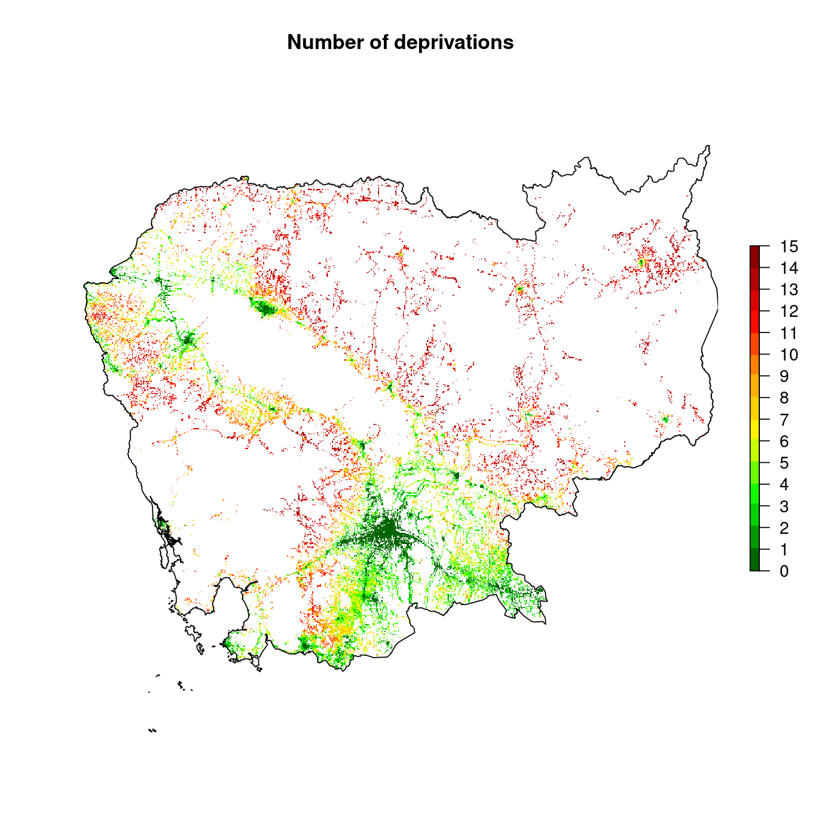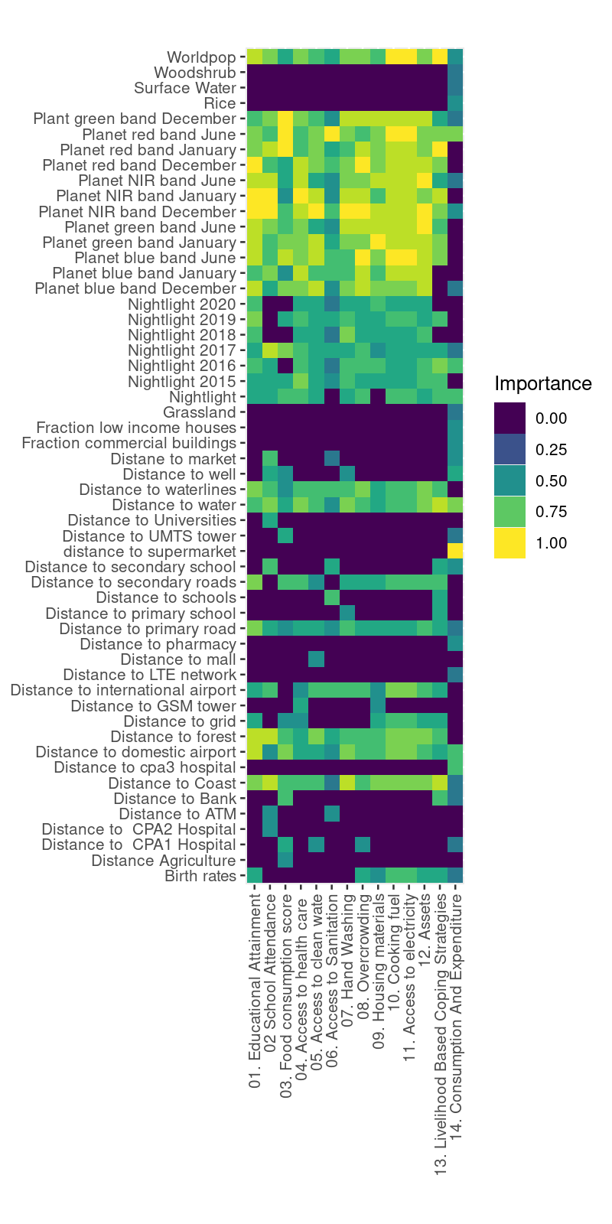វិធីសាស្រ្ត
ទិន្នន័យធំមានសមត្ថភាពធ្វើបដិវដ្ដវិស័យមនុស្សធម៌។ ព័ត៌មានត្រឹមត្រូវ និងទាន់ពេលវេលា ជាឧបសគ្គចម្បងក្នុងការត្រៀមខ្លួនក្នុងការទប់ទល់នឹងហានិភ័យគ្រោះមហន្តរាយ ហើយមានសារៈសំខាន់បំផុតក្នុងការបំពេញតាមគោលដៅអភិវឌ្ឍន៍ប្រកបដោយចីរភាព (SDGs)។
ព័ត៌មានភូមិសាស្ត្រអាចដើរតួនាទីយ៉ាងសំខាន់ក្នុងការសម្រេចបាននូវការអភិវឌ្ឍន៍ប្រកបដោយនិរន្តរភាព និងកាត់បន្ថយភាពងាយរងគ្រោះ និងការខ្វះខាត តាមរយៈការគូសផែនទីភាពងាយរងគ្រោះនៅទីតាំងភូមិសាស្ត្រ និងពេលវេលាផ្សេងៗ។
នៅក្នុងការសិក្សានេះ ទិន្នន័យ Big Earth ត្រូវបានបំឡែងទៅជាសូចនាករ ដោយប្រើប្រាស់ទិន្នន័យដែលបានមកពីអង្កេតសេដ្ឋកិច្ច-សង្គមកម្ពុជា។ បន្ទាប់មក សូចនាករត្រូវបានបំឡែងទៅជាសមាសភាគ ដែលបន្ថែមភាពងាយរងគ្រោះជារួម។

គោលដៅអភិវឌ្ឍន៍ប្រកបដោយចីរភាពទាំង១៧
វិធីសាស្រ្ត Random Forest ត្រូវបានបង្វឹកជាមួយនឹងបណ្ដុំព័ត៌មានភូមិសាស្ត្រមួយចំនួនធំ ឧ. ចម្ងាយផ្លូវ បណ្តាញអគ្គិសនី ពន្លឺពេលយប់ មណ្ឌលសុខភាព សាលារៀន គម្របដីជាដើម និងទិន្នន័យអង្កេតសេដ្ឋកិច្ច-សង្គមកម្ពុជា។ បន្ទាប់មកវិធីសាស្រ្ត Random Forest ត្រូវបានអនុវត្តក្នុងទម្រង់ប្រូបាប៊ីលីតេ ដើម្បីប៉ាន់ប្រមាណប្រូបាប៊ីលីតេនៃការខ្វះខាតនៅទូទាំងប្រទេសនៅលើក្រឡាចត្រង្គទំហំ 100 គុណនឹង 100 ម៉ែត្រ។ សារៈសំខាន់អថេរនៃសូចនាករផ្សេងៗគ្នាត្រូវបានបង្ហាញក្នុងរូបទី១។
យើងបានប្រើសំណុំទិន្នន័យបើកចំហនៃអគាររបស់ Bing ដើម្បីគណនាការខ្វះខាតក្នុងកម្រិតគ្រួសារ។ សំណុំទិន្នន័យនេះត្រូវបានបង្កើតដោយប្រើវិធីសាស្រ្តMachine Learning ដោយផ្អែកលើរូបភាពដែលមានគុណភាពបង្ហាញខ្ពស់។ វាផ្តល់ព័ត៌មានអំពីទីតាំងអគារក្នុងប្រទេសកម្ពុជា។

រូបភាពខាងក្រោមបង្ហាញពីចំនួននៃការខ្វះខាតក្នុងមួយគ្រួសារនៅកម្រិតប្រទេស។ សំណុំទិន្នន័យនេះ អាចត្រូវបានស្វែងរកយ៉ាងលម្អិតនៅក្នុងផ្នែកផែនទីនៃគេហទំព័រនេះ។

FIG. 1 រូបភាពទី១ សារៈសំខាន់អថេរនៃសូចនាករផ្សេងៗគ្នា

The dimensions, indicators and definitions of vulnerability.
| Dimension | Indicator | Definition | Weight |
|---|---|---|---|
| Education | Educational Attainment | No member of the household aged 12 years old and older who has completed at least siz year of schooling. | 1/10 |
| School Attendance | At least one child age 6-14 years old as a household member is not currently attending to school. | 1/10 | |
| Health | Food consumption score | Household has Food Consumption Score (FCS) lower than 38.5 during the past week. | 1/25 |
| Access to health care | At least one household member was sick/ill and did not access to health care services in the last 30 days. | 1/25 | |
| Access to clean water | Main source of drinking water is not safe or 30 minutes or longer walk from home (round trip). | 1/25 | |
| Access to sanitation | Household has unimproved or no sanitation facility of it shares the improved sanitation facility with other households. | 1/25 | |
| Hand Washing | There is no observed place of hand washing or soap and water are not observed at an observed place of hand washing. | 1/25 | |
| Living standard | Overcrowding | A room is shared with more than 4 people | 1/30 |
| Housing materials | The naterials of the roof, walls or floors are non-improved (natural or rustic materials). | 1/30 | |
| Cooking fuel | The main source of cooking fuel is natural product (charcoal or wood). | 1/30 | |
| Access to electricity | The household has no access electricity (sources from public electrical grid). | 1/30 | |
| Assets | The household does not own more than two of these assets, radio TV, telephone, computer, refrigerator animal cart, bicycle, motorbike, or machine boat, and does not own car or truck. | 1/30 | |
| Livinhood based on coping strategies | During the past 30 days any household's member has to engage in any of the following activities bacause there was not enough food or lack of money to buy food. | 1/30 | |
| Employment | Unemployment | At least one labor force (aged 15-40 years old) is unemployed. | 1/10 |
| Underemployment | At least one labor force person (aged 15-64 years old), who is currently working does not work full time and would like to work more hours. | 1/10 | |
| Monetary | Consumption and Expenditure | Consumption and expenditure are lower than national poverty line. | 1/5 |